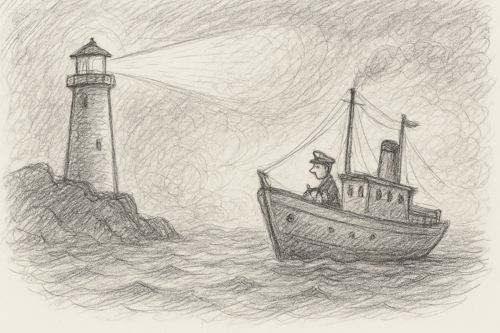The Lighthouse & The Ship
Illustrates Fixed Constraints, Humility, Systems Thinking
In Agile coaching, a common frustration sounds like this: “Why won't they just do what we told them?” Leaders set direction, teams get instructions, and yet misalignment and confusion still take root. This parable invites a different perspective. One that shifts from control to clarity. One that sees leadership as a source of guidance rather than command.
The story reminds us that clear purpose and visible signals help teams navigate more effectively than rigid top-down direction.

Once there was a ship lost in thick fog. The captain stood at the helm, eyes squinting into the gray. His crew was alert, waiting for orders, but the charts were outdated and the compass needle twitched uncertainly.
Far ahead, a faint light appeared.
"Turn to port!" the captain shouted, assuming the light came from another ship.
A calm voice crackled through the radio. "This is the lighthouse. I recommend you adjust your course."
The captain bristled. "I am an experienced sailor. You move."
The voice replied again, steady and sure. "I cannot move. I am a lighthouse."
The captain paused. Realization dawned. He adjusted the ship's heading just in time to avoid the jagged rocks hidden in the fog.
From that day forward, the captain changed. He issued fewer orders. He listened more. He began to trust the signals around him. And in time, his crew grew more confident, more connected, and more capable of steering through uncertainty together.
The lighthouse had not forced the ship to change. It simply revealed what was true and let the captain choose his course.
Lessons Learned
Guidance Is Not Control
Leaders often try to direct every step their teams take. But control can breed dependence. Like the lighthouse, effective leadership offers clarity so that others can act on their own.
Autonomy Needs Orientation
Just as a starfish grows from a severed leg, resilient Agile organizations learn and regenerate through setbacks. Teams that embrace experimentation and learning loops do not fear failure. They adapt and grow.
Systems Shape Behavior
The lighthouse did not yell or escalate. It simply existed as part of the environment. Agile coaches do their best work when they focus on adjusting the system, not the people. Better signals lead to better decisions.
Influence Works Through Visibility
The lighthouse did not convince the captain with arguments. It showed him reality. Agile coaches reveal patterns, risks, and truths that help teams self-correct.
Listening Enables Learning
The captain's turning point came when he paused and listened. Leaders who slow down to observe, reflect, and absorb what is happening around them often find better ways forward.
Coaching Tips
- Use this Story to Reframe Influence: When stakeholders want to "make teams comply," share this parable and ask, "What if we were more like lighthouses?"
- Map your Signals: In retrospectives or strategy sessions, identify what "lighthouse signals" exist in the organization. Where are the guiding lights? Where are they missing?
- Link to Systems Thinking: Help teams see their role within the larger system. A small shift in visibility or feedback can change behavior without coercion.
Lighthouses do not steer ships. They shine so others can steer wisely.
In Agile environments, coaches and leaders who act like lighthouses give teams the tools to navigate complexity with confidence. When teams have clear signals and space to move, they rarely need to be told what to do.
If your team feels lost in the fog, maybe what they need is not louder voices, but a steadier light.


